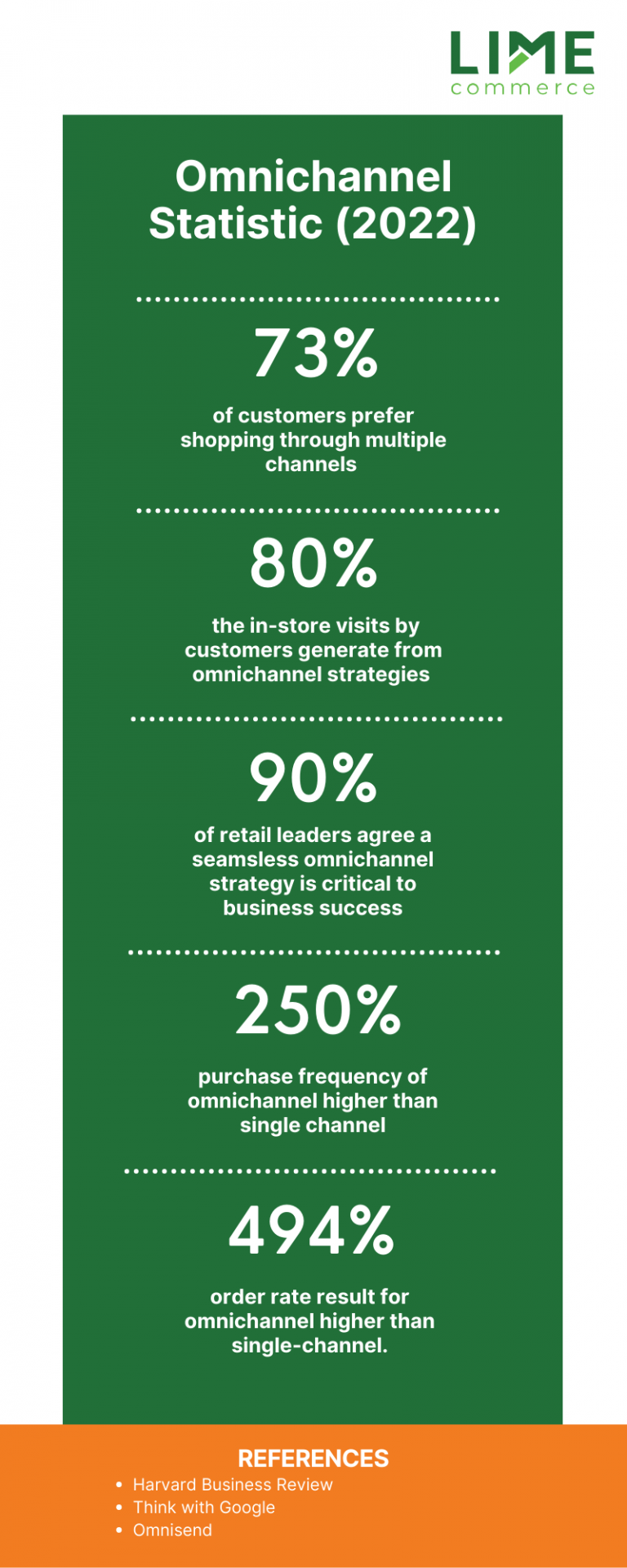
The Ultimate Guide to Omnichannel Customer Experience
16 September 2022
By attalime
You might already know omnichannel terms but are not implementing this approach. Or even worse, you didn’t realize how this approach benefits your business. Whereas many companies already use omnichannel as part of their strategy. Well, omnichannel customer experience is no longer an aspiration, but it is fast becoming a must-have for any modern business.
It is because the customers want to interact with your brand in all channels they use. They want to reach out and learn more about your products and services through Google searches, social media, videos, marketplace, and mobile apps. That’s why your brand or business needs to use omnichannel customer experience to win your customers’ hearts and the competition.
So, let’s dive deep into omnichannel customer experience, its benefit, and the best practices. You can also learn from the popular brands that have mastered omnichannel marketing in this article.
What is Omnichannel Customer Experience?
An omnichannel customer experience is when a company promotes, sells, and supports prospects and customers across multiple channels, making each interaction or touchpoint, such as social media, SMS, chatbot, etc., as a single part, one frictionless whole. This approach allows customers to start their brand experience on one channel and seamlessly continue on another.
Omnichannel in Numbers
Every business owner or brand always loves numbers. Especially when talking about the opportunity and the investment. And this is an interesting statistic about the omnichannel approach that every marketer or business owner should know.

Why Is Omnichannel Customer Experience Important?
Omnichannel marketing is now essential for businesses because it helps to reach customers and create a positive experience for them at every stage of their lifecycle. So it could improve the quality of customer interactions and build greater customer engagement. It also reduces churn and creates a positive reputation for the brands or businesses.
To make it easy to illustrate, you are tired after a long day at work and want a cup of coffee before heading home. Your favorite coffee shop gets packed at night, so you are too tired to queue. Wouldn’t it be nice if a coffee shop had the option to pre-order coffee via an app? And that is what Starbucks did. Starbucks really made it easier for customers to order and pay. Their mobile payments increase by 29% of their transactions. Starbucks not only improved the customer experience with omnichannel technology, but it also increased sales.
The Difference in Omnichannel Customer Experience vs. Multichannel Experience
Most companies or businesses might be already familiar with or use multiple channels for sales and support. But it doesn’t automatically make for an omnichannel experience. Multi-channel businesses can have websites, social media accounts, physical stores, and more. However, each channel operates independently in its own silo. It might have a different goal and strategy for each channel.
Meanwhile, an omnichannel allows the brand to build interaction with consumers across different channels. It also focuses on creating integrated, real-time experiences rather than unique strategies for each channel. All the business channels are closely intertwined.
Another thing is multichannel marketing. All the communication channels work in isolation where no connection exists between them. But for omnichannel, all the channels work cohesively and in harmony between each channel.
The Benefits of Omnichannel Customer Experience
Building a robust omnichannel approach has several benefits, such as improving customer retention and generating higher revenue. Interesting facts by Accenture in 2018 found that one in five customers will leave a company if their sales channels lack integration. And here are the most important an excellent omnichannel approach benefits both you and your customers:
-
More options for customer
Modern customers expect a seamless experience with brands. You can stay relevant and interact most conveniently by offering a variety of built-in channels. Besides, customers also get a consistent experience, whatever the channel and devices to access your brand or business. This consistency helps build a connection with your users and provides a better customer service experience.
-
Improved customer retention and loyalty
As a business owner, you must believe that happy customers will become your business’s cheerleaders and loyal customers who share positive experiences with their cohorts. Investing in your company’s customer experience strategy can keep your customers happy and grow your business. According to McKinsey, 83% of B2B leaders believe omnichannel strategies are more profitable for winning new business than traditional face-to-face methods.
-
Gather better data
Omnichannel journeys provide rich data sources. You can use this data to understand your customers better, gain valuable insight into where they are struggling, and improve your service.
-
Provides a comprehensive overview of the customer journey
An omnichannel strategy allows you to track customer behavior across channels for a more holistic view of customer behavior. For example, measuring your social channels with tools like Hootsuite or Sproutsocial gives you detailed data that helps you better understand your customers’ behavior and needs.
-
Differentiate your brand from the competition
Positioning your business based on experience will help you stand out from the competition. Outperform your competitors by delivering a great customer experience across all touchpoints. A survey performed by IFS Global found that less than 20% of companies surveyed in 2021 say they provide frictionless customer experiences and win the customer better than competitors.
How to Build the Omnichannel Customer Experience
If you are wondering how to start an omnichannel customer experience, here are a few suggestions you may use to combine more than one channel.
1. Map the customer journey
If you want to create a seamless omnichannel customer experience, you must fully understand your customer’s journey. In other words, every touchpoint where a customer begins, leads to a purchase and goes on.
Mapping the customer journey also helps identify gaps and issues. Once these are live, you can tweak them and streamline the shopping experience across channels to increase sales and improve convenience.
2. Open to feedback
Customer feedback gives the information you need to improve the customer’s journey and could create a more cohesive customer experience. So, collect reviews and listen to the customers’ feedback. Take this opportunity to discover how the customers want to engage with your brand. It allows you to build an omnichannel approach tailored to your customer’s needs.
You can submit your survey via email or mobile app. You can also generate pop-ups on your website for customers to rate their experience and provide comments and suggestions.
3. Choose the right technology
A seamless user experience is impossible without the right technology. Support agents should be able to reach customers via live chat, video call, voice call, mobile app, etc., depending on their preferred method of communication. To create an authentic omnichannel customer experience, you need to bring all this data together in one customer view. That way, no matter what channel your customers are accessing, your team will have all the information at their fingertips and seamlessly pick up where they left off.
4. Identify your stakeholders
Implementing an omnichannel experience doesn’t happen overnight. It must work closely with multiple departments, such as sales, marketing, customer service, and product teams. Ultimately, a cohesive customer journey depends on a cohesive internal approach to getting it done.
If all this seems overwhelming, we recommend starting small and gradually changing the customer journey across more platforms. You can tune your main channel experiences first and then extend those experiences to multiple supporting platforms.
Omnichannel Customer Experience Best Practices
Now you know how to build an omnichannel approach, let’s look at the best practices that you can implement the omnichannel strategy:
1. Build buyer personas
The essence of business is understanding customer profiles, which is also the cornerstone of an omnichannel customer strategy. It includes understanding customer preferences, priorities, buying habits, and interactions across all communication channels. After gaining insight, select preferred channels that need a solid presence to help your customers make buying decisions.
2. Prioritize mobile compatibility
In the age of digitalization, the number of mobile shoppers is increasing daily. Given the heavy use of mobile devices in buying decisions, your omnichannel strategy should address this activity while embracing mobile-first concepts. Remember, 50% of your customers may switch to other brands if they don’t get a smooth mobile-friendly experience while browsing your website. Make sure your brand’s website is mobile-friendly, mobile payments work smoothly, and your site is optimized overall.
3. Be consistent
A Harvard Business Review study found that nearly 46,000 shoppers found that 73% of participants used multiple communication channels as part of their customer journey. Brands must establish a cross-sales presence so that their customers receive consistent customer service across all channels. To deliver a consistent omnichannel customer experience, you should consider browsing history and prioritize user experience across devices.
4. Build your social presence
If you plan to implement a successful omnichannel strategy across all communication channels, you must respond proactively to customer requests across all channels. An omnichannel customer experience is incomplete without a brand’s social presence. LinkedIn research shows that a sales rep with high network activity is 45% more likely to see sales increase than him and 51% more likely to cover a sales offer. Customers tend to post messages on your brand’s social media platforms, and you need to be able to respond promptly to convert them into potential leads and provide a seamless customer experience.
5. Integrate all channels
Brands cannot deliver a personalized and seamless customer experience if their retail system is not functioning properly. An omnichannel strategy is only possible when systems such as shopping carts, checkout systems, mobile apps, and payment systems are integrated. Connecting and optimizing these systems is critical to providing vital metrics for determining the performance of existing marketing and sales strategies and the results of the current omnichannel strategy.
6. Improve customer interactions
Interactions with customers can be divided into two aspects. They are either offline or digital. Today’s customers prefer to interact digitally, but many want to go to a store and talk to people who represent their brand. Creating a personalized and enjoyable shopping experience is the primary motivation for omnichannel strategies to build long-term customer relationships. It is achieved by giving equal importance to all communication channels.
7. Encourage self-service
Self-service and FAQs are recognized as one of the fastest ways to deliver a customer experience across all communication channels. It can be displayed on your brand’s websites, social media platforms, or online communities. Moderators must edit all replies and provide precise instructions to help customers resolve their issues. Empower your customers to use their preferred channels and keep them close at hand. Creating trusted self-service empowers customers to self-solve problems and frees account managers to focus on matters.
8. Focus on SMS and email marketing personalization
SMS and email are some of the customers’ most popular channels to engage with brands. Sending personalized offers via SMS or segmented emails, rather than bulk emails, has proven to be an effective way to convert potential buyers into repeat customers. So the idea is to segment your target audience based on their preferences and needs and send them personalized content while integrating email and SMS marketing into your omnichannel strategy. Research shows that over 83% of customers are personalized. They want a unique shopping experience, and offering the same can increase sales by up to 30%.
Example of Omnichannel Customer Experience
You might start considering omnichannel for your brand or business and wondering how to go about it. And here are four great examples of companies delivering omnichannel experiences to their customers. But always note that there isn’t a one-size-fits-all approach because all these examples inspire you on how omnichannel can be implemented well in business.
1. Amazon
Amazon is one of the most famous examples of omnichannel in e-commerce. They do their best to give their customers a nearly identical experience on each platform, whether using a phone or a desktop computer.
For example, when customers log in, they can add items to their cart from their computer, and the cart syncs to their mobile app in real-time.
The experiences Amazon creates are reaching other companies as well. When Amazon Prime members shop at Whole Foods stores, they can access their QR code in the Amazon app on their smartphone and scan it in-store for instant access to discounts and payments.
With a solid omnichannel strategy, Amazon continues to grow. Earnings for the third quarter of 2021 reached about US$110.81 billion, surpassing US$96.15 billion for the same quarter of 2020.
2. Starbucks
Starbucks omnichannel experiences are carefully designed to encourage repeat purchases while building customer relationships. The hugely popular mobile app allows customers to order, choose a pickup location, pay, and go to a physical location for pickup, and a loyalty program that would enable the customers to get free drinks by redeeming points.
When customers shop with their Starbucks Card, they can reload via the app, website, in-store, or mobile device. And their total reward points are updated across all platforms. Coffee lovers can make mobile orders on the go, gift a Starbucks digital card, find nearby stores, and even tip their baristas.
The coffee giant is taking omnichannel to the next level by partnering with Spotify to create a “music ecosystem.” In this ecosystem, customers with Spotify Premium subscribers can use the Starbucks app to listen to whatever music is playing in one of their shops. Customers can listen to playlists inside and outside the cafe.
3. Sephora
Sephora makes many top retailer lists for omnichannel marketing because of its successful blend of online and in-store experiences. The in-store brand experience is matched by beauty tips, knowledgeable sellers, free makeovers, and products to try. Online, customers use their Beauty Bag accounts to make purchases. You can track lipstick color, scan products, watch tutorials, and manage your wish list. By offering this experience to its customers, this leading beauty retailer increased mobile orders by nearly 100%.
4. Disney
You can’t talk about omnichannel without Disney. They set the bar so high that other retailers aspire to it. Even Hubspot said, “Disney gets omnichannel experience right, down to the smallest details.” The experience starts on the website and moves on to My Disney Experience tools that you can use to plan every detail of your trip. Once at the park, visitors can use the app to find rides and attractions and even see wait times for popular rides. But that’s not all: MagicBand, a wristband that allows visitors to:
- Unlock hotel room doors and charge food and goodies
- Enter the park
- Check-in for rides at Fastpass gates
- Get photo
And all aspects are consistently branded, easy to use, and set an example of omnichannel reaching new heights.
The Takeaways
Again, it’s understandable for a marketer to ask if the omnichannel approach is worth it before considering it. And here are some key stats we want to share to illustrate and convince you better about the importance of omnichannel marketing.
- A marketer is experiencing 250% higher engagement rates using an omnichannel strategy than single-channel marketing.
- The average order value was 13% higher when marketers used an omnichannel strategy.
- An omnichannel strategy has improved the customer retention rate by 90%.
Yes, we agree that omnichannel marketing may seem overwhelming at first. Mainly because you need to combine marketing and technical expertise to sift through the enormous amounts of data to drive a successful strategy, but it is worth the effort because it helps create a positive customer experience that drives loyalty.
Suppose you want to build an omnichannel strategy for your business. In that case, Lime Commerce is here, ready to help you to build omnichannel marketing to enhance your customer experience and grow your business. You can discuss your problem or needs by contacting us, and we’ll gladly help you.
